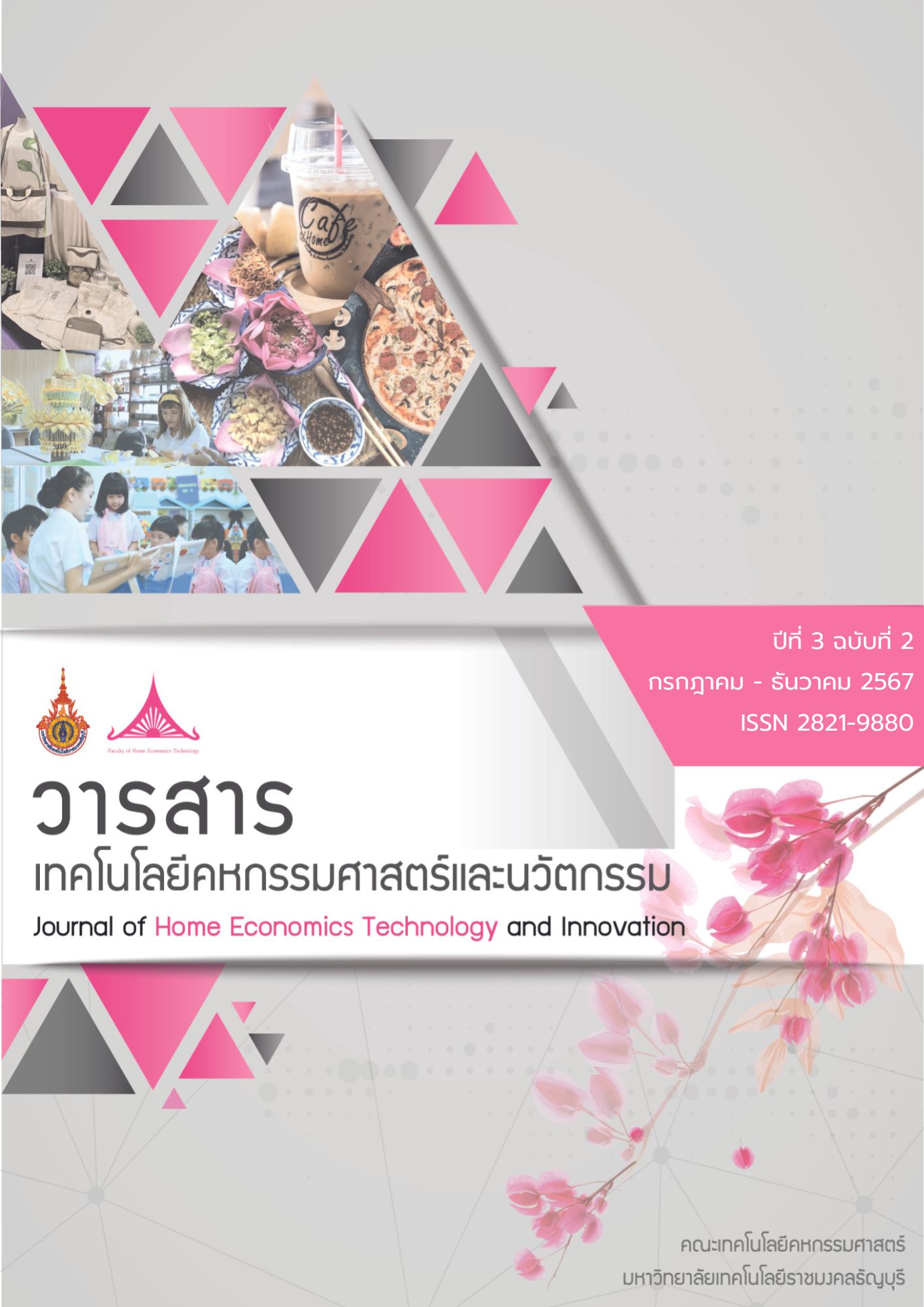Development of Mulberry Jam Fortified with Banana Peel Powder
Main Article Content
Abstract
This research focused on developing mulberry jam fortified with banana peel powder to address food waste concerns while enhancing the product's nutritional value. The objectives were to: 1) establish a standard formula for mulberry jam production, 2) investigate the effects of varying banana peel powder fortification levels (0%, 1%, 3%, 5%, and 7%), and 3) evaluate the physical, chemical, and sensory characteristics of the products. Results revealed that the optimal jam formula consisted of 44.54% mulberry fruit, 27.84% water, 0.45% pectin, 28.39% brown sugar, and 0.45% banana peel powder (1% level), which received the highest overall acceptance score of 7.47±0.73 on a 9-Point Hedonic Scale. Physical and chemical analysis of the jam fortified with 1% banana peel powder showed total soluble solids of 46.50±1.32 °Brix and water activity (aw) of 0.897±0.003. No significant statistical differences were found in total soluble solids among the 1%, 3%, and 7% fortification levels. Although higher fortification levels (3% and 5%) could potentially reduce more food waste, improvements in texture and taste characteristics are needed to enhance consumer acceptance. Future research should explore shelf-life extension, taste balance optimization (such as increasing acidity), and the use of fresh mulberries instead of frozen ones to enhance flavor quality. This research demonstrates the potential of incorporating banana peel powder into mulberry jam, not only reducing food waste but also creating value-added products aligned with sustainable Zero Food Waste principles.
Article Details
Articles published are copyright of the Journal of Home Economics Technology and Innovation. Rajamangala University of Technology Thanyaburi The statements contained in each article in this academic journal are the personal opinions of each author and are not related to Rajamangala University of Technology Thanyaburi and other faculty members at the university in any way Responsibility for all elements of each article belongs to each author. If there is any mistake Each author is solely responsible for his or her own articles.
References
กนกกานต์ วีระกุล, จิราภรณ์ สอดจิตร, และเหรียญทอง สิงห์จานุสงค์. 2558. การสกัดใยอาหารจากเปลือกกล้วยน้ำว้าโดยใช้เอนไซม์
การนำไปประยุกต์ใช้ในผลิตภัณฑ์โยเกิร์ต. โรงเรียนการเรือน, มหาวิทยาลัยสวนดุสิต และคณะเกษตรศาสตร์
ทรัพยากรธรรมชาติและสิ่งแวดล้อม, มหาวิทยาลัยนเรศวร.
ยุพารัตน์ โพธิเศษ, และ เนวิชญานิ์ วุฒินิธิศานันท์. (2021). ชนิด และ ปริมาณ น้ำตาล ซูโครส ต่อ กิจกรรม การ ต้าน อนุมูล อิสระ
ของ แยม ลูก หม่อน. วารสาร เกษตร พระจอมเกล้า, 39(2), 165-171.
ตาเย๊ะ นุชเนตร, ต่วนกาจิ ต่วนนัจวา, และ อาลี ฮานาน. 2019. “การพัฒนาผลิตภัณฑอาหารฮาลาลท้องถิ่น: แยมส้มแขกแคลอรี่ต่ำ”. วารสารวิทยาศาสตร์และเทคโนโลยี มรย. 4 (2). Yala, Thailand:54-65.
https://li01.tci-thaijo.org/index.php/yru_jst/article/view/187532
สัมฤทธิ์ โม้พวง. (2549) การผลิตถ่านและถ่านกัมมันต์ จากเปลือกกล้วยและก้านเครือกล้วย /. มหาวิทยาลัยนเรศวร],:ม.ป.ท. 10.14457/NU.res.2006.8
สุภารัตน์ อำนาจ, ภัฒณษอรณ์ กาศสกุล, อนุกูล จันทร์แก้ว. (2566). ผลิตภัณฑ์แปรรูปจากหม่อน. แหล่งที่มา: https://rae.mju.ac.th/goverment/20130325103535_2013_rae/Doc_25630130091421_446065.pdf
ศิริลักษณ์ ริ้วบำรุง. (2564) แยมหม่อน ทำแยมเองแบบเลือกจากผลไม้รสเปรี้ยว และระดับความหวานด้วยตนเอง. แหล่งที่มา: https://readthecloud.co/thai-mulberry-jam-making/
Lichanporn, I., Nanthachai, N., Tanganurat, P., & Akkarakultron, P. (2023). การพัฒนาสูตรกล้วยกวนปรุงรสโดยผสมผง เปลือกกล้วยและน้ำเสาวรส. Journal of Applied Research on Science and Technology (JARST), 22(1), 90-103.
Siamchemi. ม.ป.ป. เพคติน (Pectin) ประโยชน์ และสรรพคุณเพคติน. แหล่งที่มา:
https://www.siamchemi.com/%E0%B9%80%E0%B8%9E%E0%B8%84%E0%B8%95%E0%B8%B4%E0%B8%99/, 5 สิงหาคม 2566.


